Alder Trees: Leaves, Bark, Flowers, Cones – Identification (Pictures)

Alder trees (botanical name Alnus) are tall deciduous trees known for their drooping flower clusters and brown woody cones called strobiles. Several species of alder trees are native to North America and Europe, with the Red Alder (Alnus rubra) and Black Alder (Alnus glutinosa) being the two most common.
Alders grow as tall shade trees or large shrubs that thrive in marshy, damp ground. It’s easy to identify alders in landscapes due to their vast, rounded crown, serrated green leaves, and brown conifer-like cones. The alder cones develop from catkins (conical flower clusters) and stay on the tree throughout the winter, giving the bare branches a distinguishable look.
Alder trees are uncommon in residential landscapes. The large trees, wide canopy, and love of wet areas mean that they’re not ideal trees for garden landscapes. However, some smaller species of alder make excellent hedge shrubs for privacy and security.
This article is a complete guide to identifying the most common alder trees in forests, woodlands, and parks. You will find out how alder bark, leaves, flowers, and cones help identify this stately tree.
Alder Tree Facts
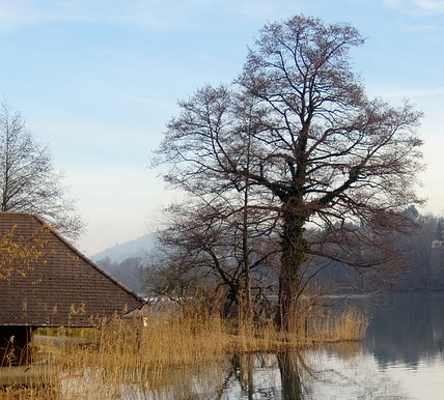
Alders are large deciduous trees that grow well in wet areas
Alder (Alnus) is a genus of flowering deciduous trees in the family Betulaceae. There are about 35 alder species, comprising of large trees and smaller shrub-like trees. Many species of alders grow between 66 and 100 ft. (20 – 30 m) tall. Most alder species thrive in USDA zones 5 through 8; however, some individual species may be more or less cold-hardy.
Generally, alders are fast-growing trees that live between 60 and 70 years. However, some alder trees live for up to 100 years.
A notable feature of the alder species is that the trees grow well in soggy, wet ground. You will find alders growing alongside rivers, stream banks, swampy ground, and wetlands. This fact makes alders popular for re-foresting land where there is poor soil or drainage.
An alder tree’s arching, conical crown is made up of crooked, gnarled branches. The arching branches are covered with shiny green pointed ovate or rounded leaves, most of which have distinct serration along the margins. Like the trunk, branches are covered with light gray to dark gray bark.
Alder trees are related to birch trees (Betula). The difference between alders and birches is their cones. Alder female flowers become woody conical cones that turn brown during the fall.
Alder Tree Leaves

Alder leaves are typically egg-shaped with serrated edge
Leaves on alder trees help to identify the individual species. Generally, alder tree leaves are egg-shaped blades with a central vein and parallel veins from the midriff to the serrated leaf edge. Some alder tree leaves have toothed edges and pointed tips, whereas others are rounded and smooth.
Leaves on the red alder (Alnus rubra), green alder (Alnus alnobetula), and white alder (Alnus rhombifolia) look similar. The ovate-shaped leaves are broader at the petiole and have serrated margins. However, white alder leaves have a more rounded rather than a pointed tip. Black alder leaves are obovate shaped like a wedge with the broader end opposite the stem.
Being a type of deciduous tree, alder trees shed their leaves in the fall. The leaves on most alder species don’t have any significant fall color. Many drop their leaves while still green. The leaves on the red alder turn a yellowish-brown color in the fall.
Alder Tree Flowers
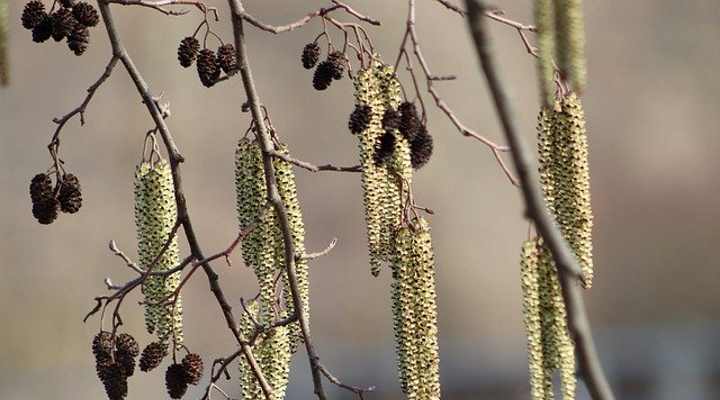
Alder male flowers (catkins) are long and slender whereas the female flowers turn to woody round cones (strobiles)
An alder tree flower is a type of slender, conical flower cluster called a catkin. Alders are also monoecious trees—meaning they have male and female flowers on the same tree. The female flowers turn into the recognizable stiff, woody cones that alder trees are known for.
Alder trees tend to bloom early in the season, sometimes in late winter. You can recognize an alder tree by the conspicuous dangling male flowers that are first to bloom. Then smaller female catkins grow upright at the end of branches. The female flowers persist on the tree until fall when they become hardened cones called strobiles.
The alder male flowers are elongated, drooping clusters that grow up to 6” (15 cm) long. The pendulous catkins are soft and limp, with a furry feel to them.
Alder flowers develop and bloom on bare branches. The colorful reddish-brown or yellow-brown catkins contrast with the pale gray, almost white bark and branches.

Close up pictures of alder male flowers (catkins)
Alder Tree Cones
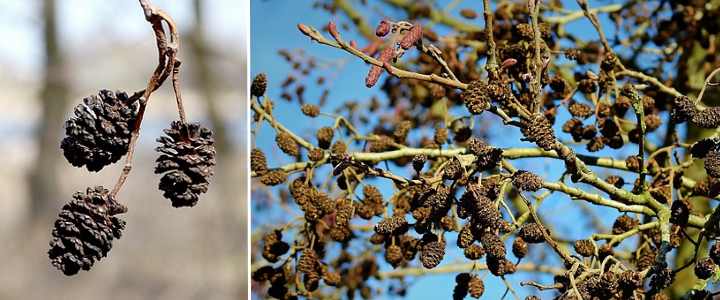
Alder cones
Cones on the alder tree are its most recognizable feature. Alder cones measure up to 1” (2.5 cm) long and have a rounded, conical, or barrel-like shape. The small, pine-like hard cones (strobiles) dangling on the end of bare alder branches help identify alder trees in late fall and winter landscapes. The hard brown alder cones (strobiles) persist on the tree until the following spring.
Alder cones contain seeds, like many conifer tree cones. However, it’s important to remember that the alder tree species is an angiosperm, or flowering plant. This contrasts with pine trees and conifers that are cone-bearing gymnosperms.
Alder Tree Bark
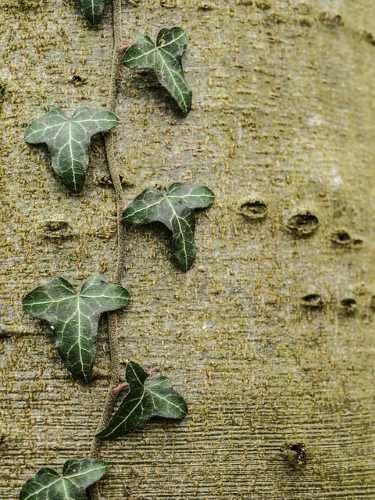
Ivy climbing on alder tree trunk
Bark on alder trees is identifiable by its smooth, ash-gray to white color, like the bark on some birch trees. As alder trees mature, the bark may become somewhat darker. It’s typical for white lichen and moss to grow on alder tree trunks—yet another way to identify this large tree.
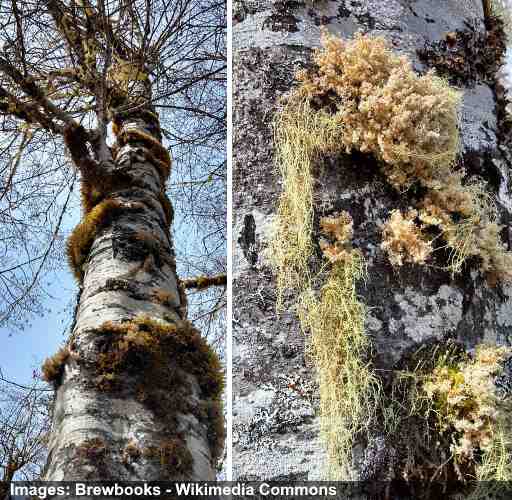
Red alder tree bark with lichen and moss
Some species of alder bark have light gray bark with identifiable reddish-orange inner bark.
Alder Wood

Alder wood
Alder trees are classed as hardwood trees. Timber from alder trees is extremely workable due to its relative softness. Alder wood isn’t as durable as walnut, ash, or maple wood. And alder is only marginally harder than softwoods such as timber from pine or poplar trees.
The attractive feature of alder wood is its light tan color and straight grain patterns. As semi-hardwood, alder lumber makes it a good choice for making furniture, cabinets, musical instruments, and wooden household items.
Alder Tree Identification
Alder trees are easily identified by their brown hard, cone-like strobiles that dangle from bare brown-purple twigs that have orange markings. You can also spot alder trees by their light gray bark and orange-brown drooping flowers. Another identifying feature of the alder trees is their pointed egg-shaped green leaves with serrated edges.
Types of Alder Trees with Pictures and Names
Let’s look in more detail at common types of alder trees. Descriptions and pictures of alder tree cones, leaves, and bark will help identify alder trees in landscapes.
Red Alder (Alnus rubra)
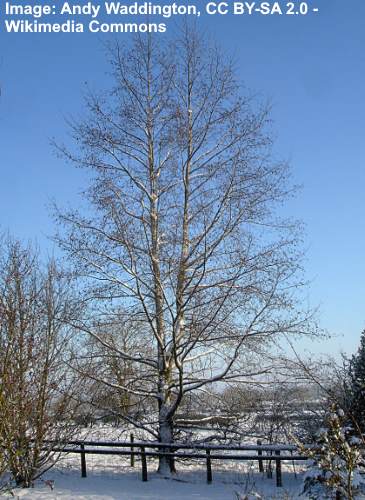
Red alder (Alnus rubra) tree
The red alder (Alnus rubra) tree is a large deciduous tree with small oval, brown wood cones, ovate leaves, and mottled light gray smooth bark. Its spreading branches create a conical shape with a slender, rounded crown. Red alder trees grow between 66 and 100 ft. (20 – 30 m) tall. The red alder tree is the largest in the genus Alnus.
As with most alders, the clusters of dangling flowers are an easy way to spot alder trees. Long, cigar-like flowers droop down in spring. Then female catkins appear that develop into red alder fruit—stiff, brown seed cones.
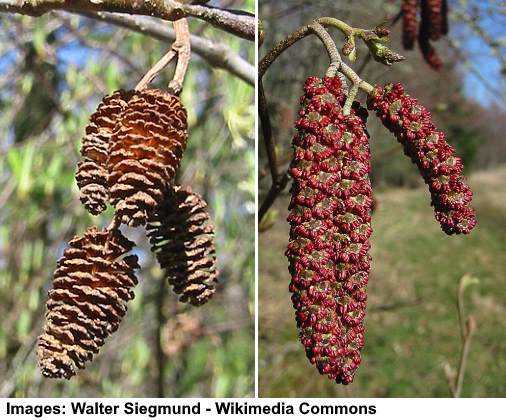
Red alder cones and catkins
Red alder cones are the primary way to identify this tree species. The dry conical, rounded alder cones measure 0.8” to 1.2” (2 – 3 cm) long. The hard, dark-colored cones persist on the tree during winter when the seeds are dispersed in winter.
A way to distinguish red alder trees apart from white alder (Alnus rhombifolia) is by the leaves. White alders have leaves that are yellowish-green and doubly serrated or finely serrated margins. Also, the teeth on red alder leaf margins are rolled under—a feature called revolute margins.
Red alder trees thrive in USDA zones 5 – 9 and are native to the west coast of North America. You’ll find red alders growing on the banks of rivers and streams and in wetlands. Red alder trees grow best in full sun and damp, infertile soil.
Red alder wood is a popular hardwood for furniture making due to its workability and pleasing appearance.
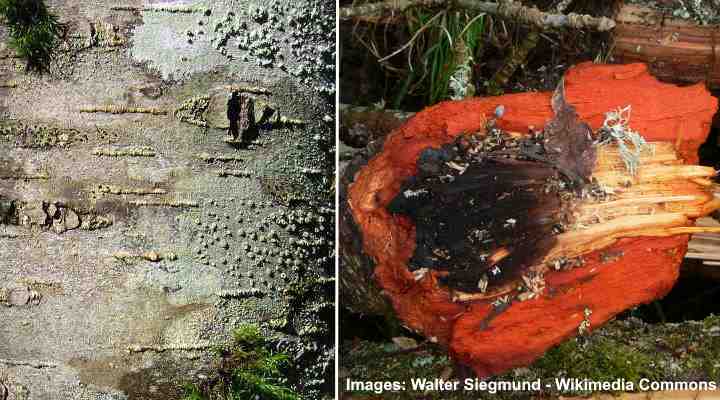
Red alder bark (left) and inner red bark (right)
The red alder tree gets its name from the red inner bark. The smooth ash-gray bark develops rusty red patches when it is scraped or bruised. You can also identify red alders in the landscape by the moss or lichen that grows on bare branches.

Red alder leaves
Alder leaves: A red alder leaf is dull, green, ovate shaped, and arranged alternately on grayish branches. Leaves measure between 2.7” and 5” (7 – 13 cm) long and have rough, serrated edges. An identifying characteristic of red alder leaves is the revolute toothed serration along the edges.
Black Alder (Alnus glutinosa)
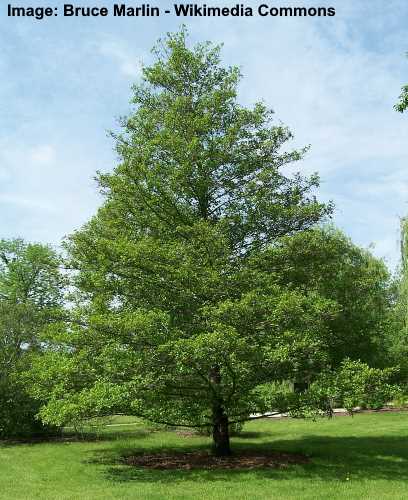
Black alder (Alnus glutinosa) tree
The black alder (Alnus glutinosa) is a tall, medium-sized deciduous tree with rounded glossy green leaves and dark-brown hard conifer-like cones. Black alder bark on immature trees is greenish-brown that gradually becomes dark gray and scaly. Black alders grow between 40 and 60 ft. (12 – 18 m) tall and up to 40 ft. (12 m) wide.

Black alder bark
The simple obovate leaves identify black alder trees. These common alder leaves have a broad, rounded end that differentiates them from other species of alder trees. Like all alder species, small woody black alder cones help identify the trees in winter landscapes.
Black alder flowers are pendulous cylindrical reddish flower clusters that grow between 2” and 4” (5 – 10 cm). The small green female flowers are somewhat smaller than the slender long male flowers. Female black alder flowers only grow up to 1” (2.5 cm) long, and they bloom on the end of branches.

Black alder catkins and cones
Black alder fruit is the characteristic black cones that develop from female catkins. The alder cones measure up to 1” (2.5 cm) and can be black or a coppery-brown color. The recognizable blackish cones grow in dangling clusters.
Black alder trees are native to Europe, where they are known as the common alder, European alder, or European black alder. Its botanical name—Alnus glutinosa—refers to the tree’s sticky, resinous substance that forms on purplish-brown buds and young leaves.
A growth feature that helps tell black alders apart from other alders is the lack of lower branches on tall trees. This means that European alders aren’t great shade trees.
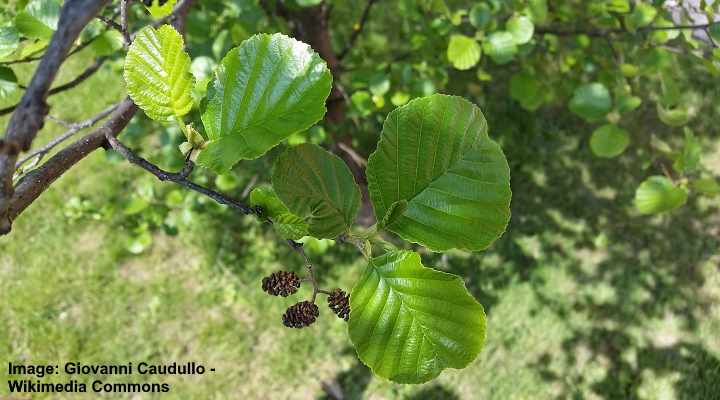
Black alder leaves
Alder leaves: Black alder leaves are egg-shaped, obovate leaves with a wide rounded end that narrows to the stem. The leaves grow 5” (13 cm) long and up to 4” (10 cm) wide. The glossy green deciduous leaves have a slightly fuzzy feel to them. Leaves drop in the fall without changing color and may even wither and die on the tree.
White Alder (Alnus rhombifolia)
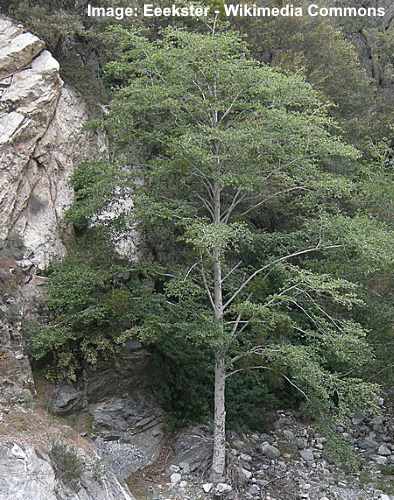
White alder (Alnus rhombifolia) tree
The white alder (Alnus rhombifolia) is a medium-sized, fast-growing tree with pale gray bark, diamond-shaped, rounded glossy green leaves, and yellowish catkins. White alders grow between 50 and 80 ft. (15 – 24 m) tall and thrive in damp, soggy ground in woodlands and forests.
White alder bark is light gray and smooth and gradually becomes a darker color with rough fissures. Like the related red alder tree, the white alder bark on mature trees has a reddish tinge.
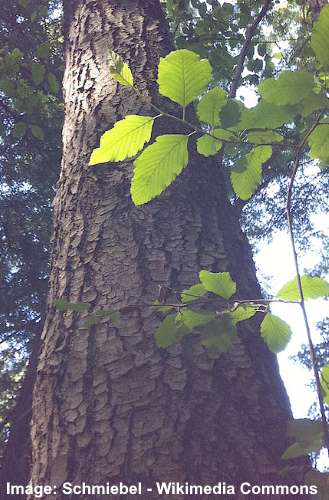
White alder bark
White alder fruit are hard, barrel-shaped dark cones that develop after the female catkins have bloomed. The woody cylindrical cones grow up to 0.6” (1.5 cm) long.
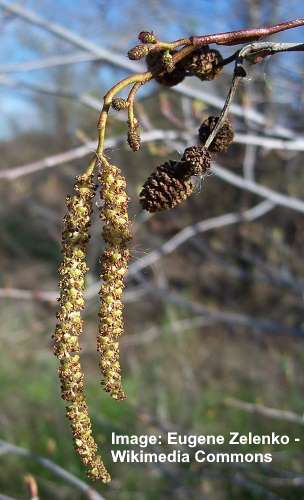
White alder catkins and cones
The botanical name of the white alder —Alnus rhombifolia—refers to the leaf shape. The leaves have an overall diamond shape with serrated edges. The difference between white alder leaves and red alder tree leaves is that they don’t have serrated revolute margins.

White alder leaves
Alder leaves: White alder leaves have an elliptic to rhomboid shape with doubly serrated edges and dark green glossy shine. Each white alder leaf grows between 2.3” and 4” (6 – 10 cm) long and up to 2” (5 cm) wide.
Speckled Alder or Grey Alder (Alnus incana)
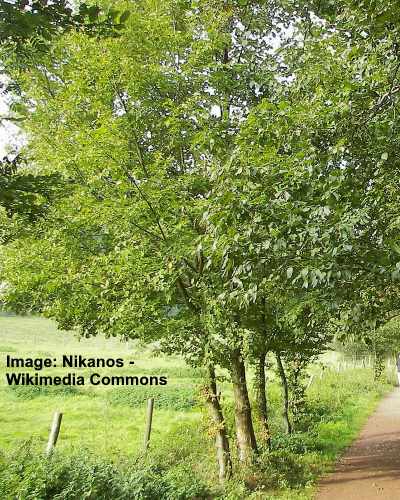
Grey Alder / Speckled Alder (Alnus incana) tree
The speckled alder (Alnus incana) is a large alder shrub or medium-sized tree. Characteristics of the grey or speckled alder are dull, rounded green leaves, pendulous spring flowers, and small stiff cylindrical cones. This deciduous alder tree thrives in USDA zones 3 – 6.
As a multi-stemmed, shrubby plant, the speckled alder grows around 8 ft. (2.4 m) tall. You can also grow the speckled alder as a small landscaping tree in wet ground. The alder tree is a fast-growing tree in full sun or partial shade that grows between 15 and 25 ft. (4.5 – 7.5 m) tall.

Gray alder bark
Speckled alder is identified by its clusters of hard, dark fruits. The alder cone-like structures start as green ovoid cylinders and become dark brown as they mature. The speckled alder cones grow besides dangling male flowers that have a yellowish color.
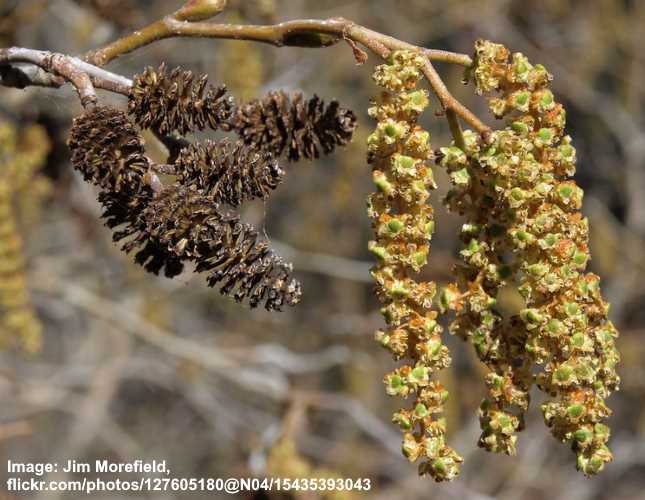
Gray alder cones and catkins
Alder leaves: Grey alder tree leaves are ovate, wedged-shaped with coarse teeth along the margins. The matte green alder leaves grow between 2” and 4” (5 – 10 cm) long up to 2” (5 cm) wide.
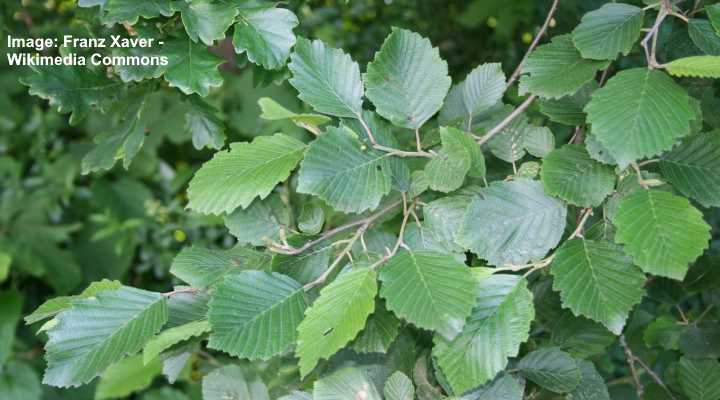
Gray alder leaves
Green Alder (Alnus alnobetula)
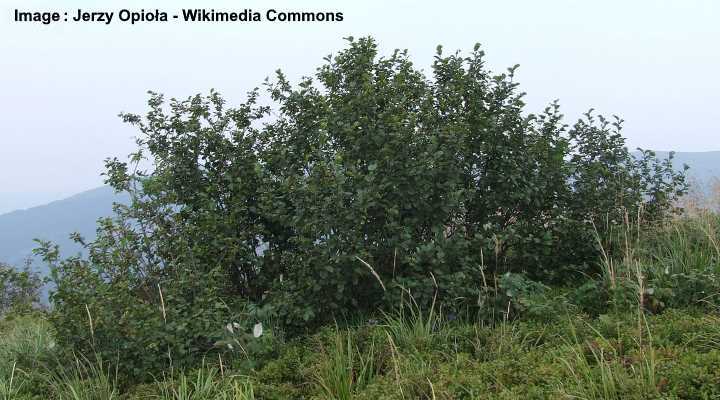
Green alder (Alnus alnobetula) shrub
The green alder is a large shrub with fuzzy green ovate to rounded leaves with characteristic uneven serration along the margins. Green alder shrubs grow up to 32 ft. (10 m) tall but are more likely to be 3 – 10 ft. (1 – 3 m). The multiple stems grow in clusters, making the green alder a suitable deciduous plant to grow as a hedge.
Green alder cones grow up to 0.6” (1.5 cm) long with an oval shape and grow in loose clusters.
Green alder flowers bloom in springtime and appear on the tree along with leaves. Like all alder trees, the male catkins are long, slender, dangling flower clusters. The female alder flowers bloom on the end of twigs and develop into fruit—the characteristic stiff alder cones.

Green alder cones and catkins
Sometimes, people refer to the green alder tree as Alnus viridis. However, most botanists consider this botanical name and incorrect and that Alnus alnobetula is the correct name.
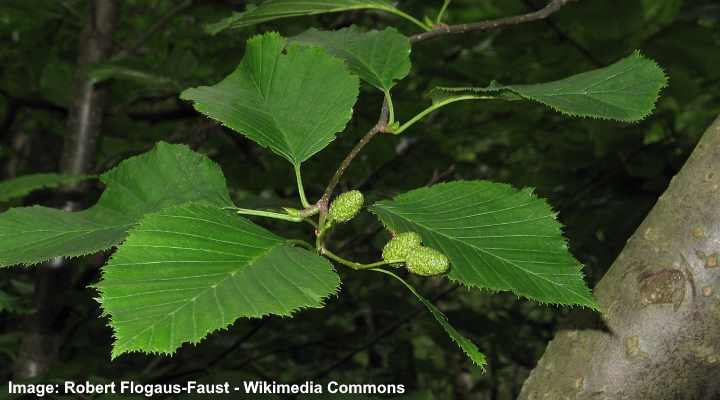
Green alder leaves
Alder leaves: Green alder leaves have a rounded, oval shape and have a smooth, green surface. The alder blades grow 3” (7.5 cm) wide and long. Typical of alder leaves, the leaf margins are sharply toothed, giving the leaves a jagged look.
Hazel Alder or Tag Alder (Alnus serrulata)
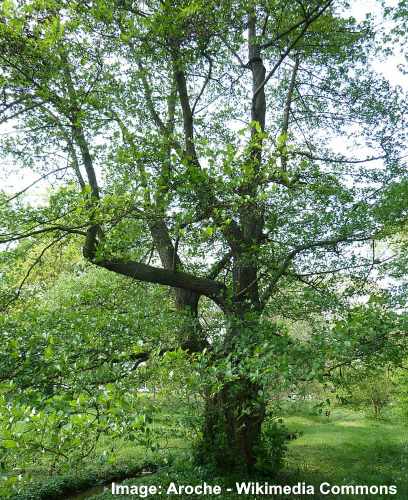
Hazel Alder / Tag Alder (Alnus serrulata) tree
The hazel alder is a multi-stemmed small shrub or medium-sized tree with smooth gray bark, brownish-yellow male flowers and bright red female flowers, dull green leaves, and 1-inch (2.5-cm) long strobiles. The hazel alder thrives in USDA zones 4 – 9, full sun, and wet, soggy soil. Hazel alders grow between 10 and 15 ft. (3 – 4.5 m) high and up to 15 ft. (4.5 m) wide.
The alder tree’s botanical name—Alnus serrulata—refers to the heavily serrated leaf edges. Other names for this tree include tag alder and smooth alder.

Hazel alder cones and catkins
Hazel alder cones are dark copper-colored nut-like cones measuring up to 1” (2.5 cm) long. The woody alder fruits look like miniature pine cones and contain winged nutlets.

Hazel alder leaves
Alder leaves: Hazel alder leaves are green, ovate, or elliptical blades with serrated margins. The relatively small, smooth, dull green leaves grow between 1” and 3” (2.5 – 7.5 cm) long. Pointed tips and a wedge-shaped base help identify hazel alder leaves.
Seaside Alder (Alnus maritima)
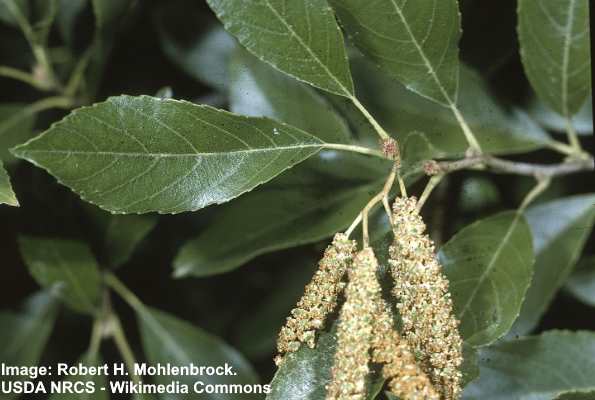
Seaside alder (Alnus maritima) leaves and male catkins
The seaside alder is a fast-growing small flowering tree or shrub. The seaside alder has dark, glossy green oval leaves with a wedge-shaped base and serrated margins. Like all alder species, its female conical flowers develop into egg-shaped cones.
As the common name suggests, Alnus maritima thrives in environments near oceans and the sea.
Related articles:
- Sweetgum Trees (Liquidamber Tree): Types, Leaves – Identification
- Linden Trees: Types, Leaves, Flowers, Bark – Identification
- Beech Trees: Types, Leaves, Bark — Identification Guide
